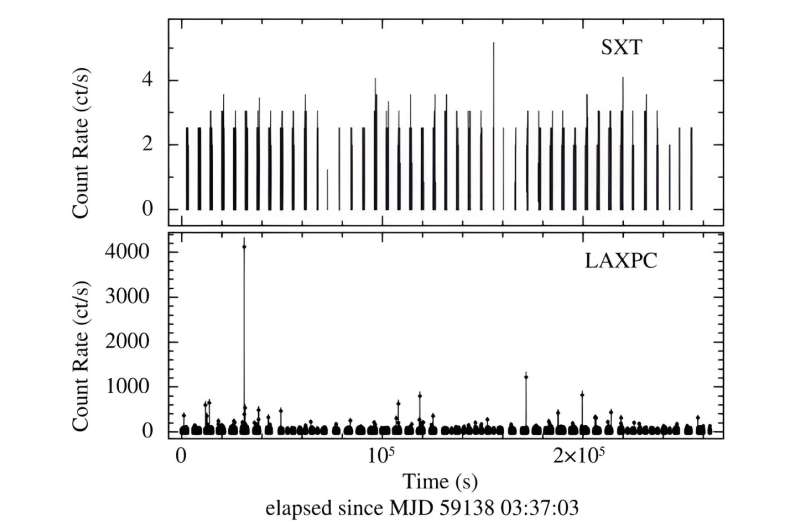October 18, 2023 report
This article has been reviewed according to Science X's editorial process and policies. Editors have highlighted the following attributes while ensuring the content's credibility:
fact-checked
peer-reviewed publication
trusted source
proofread
Bursting activity of magnetar SGR J1830–0645 observed with AstroSat

Using India's AstroSat spacecraft, astronomers have observed a magnetar known as SGR J1830–0645 during its recent bursting activity. Results of the observational campaign, published October 6 on the preprint server arXiv and accepted for publication in Monthly Notices of the Royal Astronomical Society, shed more light on the properties and behavior of this object.
Magnetars are isolated neutron stars with extremely strong magnetic fields, more than 1 quadrillion times stronger than the magnetic field of our planet. Observations show that decay of magnetic fields in these objects powers the emission of high-energy electromagnetic radiation. In general, magnetars are relatively young and their dynamic magnetosphere is endowed with strong temporal variability.
SGR J1830–0645 is a magnetar discovered on October 10, 2020 with NASA's Swift spacecraft, when it exhibited a soft, short gamma-ray burst. It has a spin period of approximately 10.41 seconds, a spin-down age of 24,000 years, and a dipole magnetic field with a strength of about 550 trillion Gauss.
A team of astronomers led by Rahul Sharma of the Raman Research Institute (RRI) in Bangalore, India, started to observe SGR J1830–0645 shortly after its discovery. For this purpose, they used AstroSat's Soft X-ray Telescope (SXT) and Large Area X-ray Proportional Counter (LAXPC).
Sharma's team conducted timing and spectral analysis of SGR J1830–0645. They detected short sub-second X-ray bursts, 0.9–10 keV pulsations, variation in the morphology of the pulse profiles with energy along with significant variation in the pulsed fraction, and a 6.4 keV emission line with an equivalent width of about 0.24 keV. Therefore, these findings make SGR J1830–0645 one of the few magnetars which have shown the presence of emission lines.
"It is possible that the emission line is a result of the fluorescence of iron due to the presence of relatively cool material near the neutron star," the scientists assume.
In total, the astronomers detected 67 bursts with an average duration of 33 milliseconds and the brightest one lasted for about 90 milliseconds. The burst spectra did not show any evidence of the presence of the 6.4 keV emission line.
The researchers noted that the pulsed fraction of SGR J1830–0645 shows a significant evolution with increasing energy as it is observed to increase for energies up to about 5 keV and shows a steep drop thereafter. This trend is different from that observed in several other magnetars.
The study also found that SGR J1830–0645 displays spectral properties typical of most magnetars in the soft X-ray band. The authors of the paper explained that the energy spectrum of SGR J1830–0645 consists of two blackbody (thermal) components along with a non-thermal power-law associated with resonantly up-scattered soft thermal photons.
More information: Rahul Sharma et al, AstroSat observation of the magnetar SGR J1830–0645 during its first detected X-ray outburst, arXiv (2023). DOI: 10.48550/arxiv.2310.04079
Journal information: Monthly Notices of the Royal Astronomical Society , arXiv
© 2023 Science X Network





















